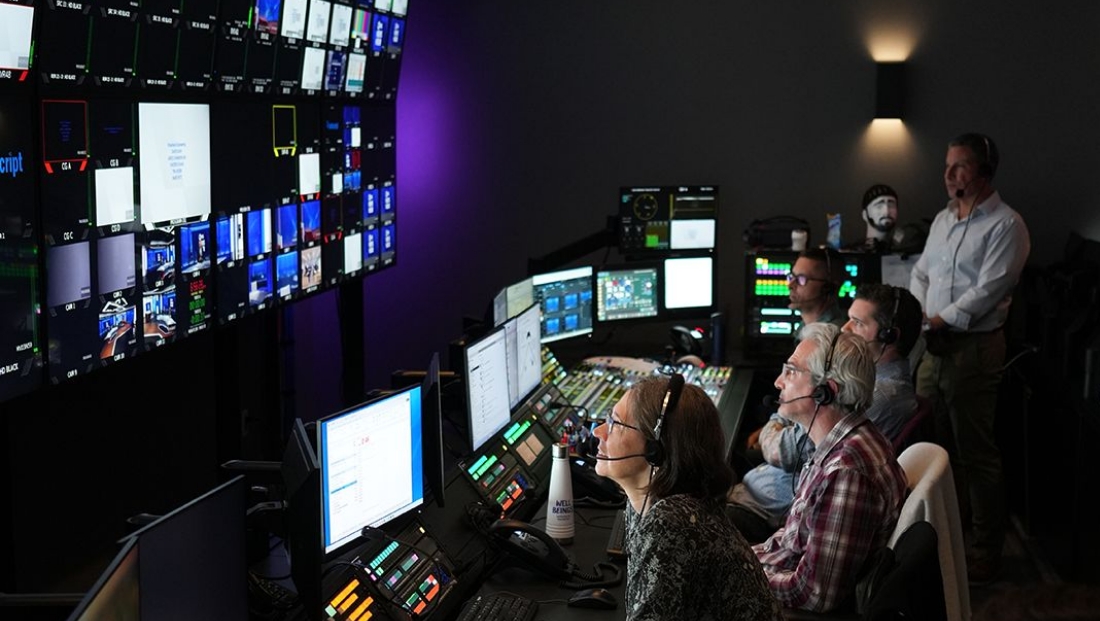Inside WETA’s SMPTE 2110 facility upgrade for “PBS News Hour”

Subscribe to NewscastStudio for the latest news, project case studies and product announcements in broadcast technology, creative design and engineering delivered to your inbox.
When “PBS News Hour” went on air from its new broadcast facility on June 10, 2024, it marked the culmination of a complex, years-long project incorporating the latest in SMPTE 2110 technology.
The public television news program, known for its in-depth coverage and thoughtful analysis, now originates from a state-of-the-art facility that rivals any in the industry – boasting a flexible set with large video walls and multiple presentation areas that support both the “News Hour” and also “Washington Week.”
This new production hub, nestled within WETA’s expanded headquarters in Arlington, Virginia, represents more than an upgrade in studios and control rooms. It’s a wholesale embrace of next-generation broadcast standards and a significant investment in public media’s future.
The project began nearly five years ago and faced numerous hurdles, including pandemic-induced delays, supply chain disruptions and the inherent challenges of integrating cutting-edge IP-based broadcast systems. Yet the result is a facility that meets today’s production needs and is poised to adapt to future technological shifts.
“PBS produces a national show that is of pretty high importance to a lot of people in the country,” noted Brendan Cline from BeckTV, the systems integrator for the build. “And they wanted to put in quality equipment, quality systems that they could trust and rely on.”
The new facility results from the expansion of the WETA building, which was constructed over a former courtyard. This addition created three new studios and a complete overhaul of the supporting technical facilities including two control rooms, two audio rooms, a comms position, a transmission room, a shading/robotic camera room, four EVS tape rooms, 15 edit rooms and rack room.
The move brings “PBS News Hour” and its sister show “Washington Week” into the main WETA building for the first time since their inception in the 1970s, consolidating operations with other broadcast functions.
Broadcast studios
The new facility includes three studios, with Studio A serving the primary needs of “PBS News Hour” and “Washington Week.” Studio B is reserved for future WETA use or promotional shoots, and Studio C features a smaller version of the “News Hour” set for redundancy or live hits.
Studio A includes a sprawling set created by designers Eric Siegel and George Allison, who also worked on the show’s well-received 2015 design. The studio’s centerpiece is a 25-foot LED wall with virtual set extensions creating the illusion of a frosted glass wall overlooking a nighttime Washington, D.C. skyline.
In addition to the main anchor area, the studio features two distinct venues on either side, each equipped with a 14-foot video wall. These spaces can be used for interviews, remote guest appearances or as standup areas for correspondents.
Six Grass Valley cameras mounted on Vinten Vantage PTZ heads are installed directly on the scenery, including two on custom-engineered, internally-lit towers that can slide along 8-foot tracks. This setup allows for more dynamic shot compositions and expanded blocking options.
Control rooms and technical spaces
Behind the scenes, the facility engineering began in the infancy of SMPTE 2110, and over the course of the multi-year project the final equipment list was refined as the industry changed.
“2110 in general is far, far more complicated than SDI builds. We’re so used to being able to hook up a cable from a router to some device, and it worked, right? In the 2110 world, you really have to be IT savvy, you have to be network savvy, you have to know how to analyze signals differently,” said Cline.
The newly constructed Rack Room, located on the second floor of the WETA building, is central to the facility’s technical infrastructure. This space serves as the nerve center for the entire broadcast operation.
“Once we had the new rack room, we came out for a little bit and installed racks and installed key systems, to be able to support the stuff that they were doing,” the project lead explained. The Rack Room houses the core routing and processing equipment, including the Grass Valley routing system, LAWO audio infrastructure, and EVS servers.
It’s also home to the facility’s robust networking equipment, supporting the SMPTE 2110 IP infrastructure. The room was designed with future expansion in mind, featuring ample space for additional racks and built-in cooling systems to manage the heat generated by the high-performance broadcast gear. This centralized approach allows for efficient maintenance and upgrades, ensuring the longevity and adaptability of the facility’s technical capabilities.
“A lot of what we did was, instead of home running a network cable from our switch to a device, we put in a lot of tie lines so that they could add stuff later,” Cline explained. This forward-thinking approach ensures the facility can adapt to evolving technological needs.
Flexibility and redundancy were key considerations in the design. The facility’s two control rooms are essentially mirror images of each other, capable of handling any production from the three studios.
“The control rooms are identical in terms of equipment complement, but they’re different sizes,” said X. This setup provides backup options and allows for simultaneous productions if needed, such as on election night or for local and national programming.
Each control room is equipped with a Grass Valley Kayenne Video Production Center with K-Frame switcher. The facility also includes identical audio control rooms, each with its own mix engines and mixer desks. All resources, including graphics and servers, are accessible from both control rooms, providing maximum flexibility and redundancy.
The project wasn’t without its challenges, many stemming from the nature of working with a non-profit organization and the complexities of renovating an existing space. The project also faced delays due to the pandemic and subsequent supply chain issues, extending the timeline and allowing for more thorough equipment evaluation and decision-making.
In addition to the main production spaces, the facility includes a Digital Center for live streaming to the internet.
The project wasn’t without its challenges, many stemming from the nature of working with a non-profit organization and the complexities of renovating an existing space.
Despite these challenges, the end result is a broadcast facility that stands among the best in the industry.
“This is a high-quality production facility with high-quality components and systems,” said Cline. “They have a beautiful new studio and production center, and I think they’ll probably get more out of the studio as they move along. I think it was very intentional to make a high-quality production space that they think they can produce a good show out of for the next decade.”
Equipment included in the new broadcast facility:
- Cameras: Grass Valley
- Switchers: Grass Valley Kayenne Video Production Center with K-Frame
- Routing System: Grass Valley
- Control System: Grass Valley
- Gateways: Grass Valley
- Audio Mixers: Lawo
- KVM: Guntermann & Drunck (G&D)
- Intercom: RTS
- Network Processors: Imagine Communications
- Multiviewers: Grass Valley
- Graphics: Ross Xpression
- Robotics System: Vinten
- Servers/Playout: EVS
- Camera Heads: Vinten Vantage PTZ
- Media Fabric: Cisco (for networking backbone)
- Digital Center: Ross Graphite all-in-one production system, Ross TRIA playout server and Ross Ultrix router
Subscribe to NewscastStudio for the latest news, project case studies and product announcements in broadcast technology, creative design and engineering delivered to your inbox.






tags
BeckTV, cisco, EVS, Grass Valley, Grass Valley Kayenne, Imagine Communications, Kayenne K-Frame Video Production Center, Lawo, PBS News, PBS News Hour, Ross Graphite, Ross Ultrix, Ross Video, Ross Xpression, RTS, SMPTE ST 2110, Vinten
categories
Broadcast Facility, Broadcast Facility Technology, Broadcast Industry News, Heroes